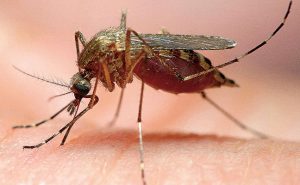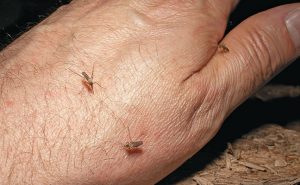Who would have guessed that in 1999, when West Nile Virus (WNV) started its sweep across the United States, a major paradigm shift would begin in the role pest management companies play in protecting people’s health? It didn’t take long for pest management professionals (PMPs) to begin conversations and lay the groundwork for a line of business ignored by most of the industry before this time. We’re talking about management plans for one of the most difficult and hideous pests of mankind, the mosquito.
Mosquitoes are still the No. 1 killer of humans, whether it’s by transmission of a parasite (malaria), or by vectoring the three principal virus families — Bunyaviridae, Flaviviridae and Togaviridae — that cause the majority of encephalitic illnesses in humans. Many arboviral (arthropod-borne virus) encephalitides have a global distribution, and until recently there were five main virus agents of encephalitis in the U.S.: St. Louis encephalitis (SLE), Eastern equine encephalitis (EEE), Western equine encephalitis (WEE), and La Crosse (LAC) encephalitis.
Things change, of course. Now, the emergence and local transmission of four relatively new viruses to the Americas have captured the attention of pathologists, medical entomologists, the news media — and therefore the public, as well as PMPs. These four mosquito borne illnesses include: WNV (1999), dengue fever (1980), chikungunya (2014 in Florida, 2015 in Texas), and Zika virus (2016 in Texas and Florida).
With local transmission of chikungunya and Zika virus in their infancy within the continental borders of the U.S., it is likely human infections will increase moving into the 2017 mosquito season. When and where these outbreaks occur will be dictated by vector biology, local and regional weather patterns, and the highly variable human factor.
Elements of mosquito management
Although mosquito management differs from purely structural integrated pest management (IPM) strategies, many of IPM’s underlying principles also apply to mosquito management. Two documents come to mind:
- Dr. Ted Gronovsky’s IPM puzzle that “pieces in” the essential elements for a successful pest management program (see Fig. 1). His idea of structural IPM blends business and technical elements in various amounts of focus to create a holistic pest management program.
- A document that started off as a “job process” chart, the original concept created by Pest Management Professional columnist Mark “Shep” Sheperdigian and myself many years ago, has since evolved into an IPM Process Guide with generalized terms to fit nearly any structural pest category that also can be applied to mosquitoes (see Fig. 2).
If your company is already providing, or plans to provide mosquito management services, be aware there are many (sometimes moving) pieces to the puzzle. Some mosquito management pieces are predictable, whereas others are highly variable. But to understand the complexity of how they all fit together, education is essential to ensure the pest management industry — and your company — are viewed as professional.
Understanding the market
Choosing a mosquito market to enter is largely based on the capabilities and limitations of your company. Industry demographics show the majority of PMPs target the residential and small business markets. Suppressive applications for these types of clientele easily fall within the capability of small-to medium-size companies.
No matter what market you choose, education should be the foundation of your mosquito management program. The company that presents the highest quality professional educational materials and takes the time to communicate with clients likely will win the lion’s share of the local mosquito management market.
For larger mosquito management programs — municipalities, townships, mosquito abatement districts, or other clients with large tracts of land — the complexity of need increases. Not only do labor needs increase, but technical understanding increases exponentially as these types of accounts may ask for active and/or passive surveillance (sentinel hosts, trapping), species identification, viral testing, larviciding, adulticiding, and even education to the public. In addition, PMPs may encounter regulatory considerations as water applications may require a National Pollutant Discharge Elimination System (NPDES) permit.
Dr. Mustapha Debboun, BCE, and a military veteran, is the director of the Harris County (Houston) Health Department’s Mosquito & Vector Control division. The department oversees a state-of-the-art mosquito management program complete with surveillance teams, mosquito biologists, environmentalists, geneticists, education specialists, and all the equipment necessary to manage mosquitoes in a densely populated city like Houston.
When asked whether it is easy to predict mosquito outbreaks and disease transmission, Dr. Debboun’s answer was a very abrupt no.
“But with help like technologies from Microsoft’s ‘Project Premonition,’ we’re getting better,” he added, smiling.
As in any good pest management program, Dr. Debboun’s health teams look for conducive conditions in convergence with increased vector numbers. They can then take action and be slightly ahead of the disease transmission cycle. Predictive? Yes, but it’s understood how quickly changing environmental factors such as rain, temperature and people can place them on the fence’s edge between proactive and reactive treatments. It’s only with diligence, hard work, and quick thinking they maintain their proactive edge.
Last, it would seem with all our science we’d be able to model these outbreaks for a better head start. One might look at the species range of Aedes aegypti and A. albopictus across North America as a good start, but it doesn’t take all the factors into consideration. That’s where the U.S. Centers for Disease Control and Prevention’s (CDC’s) Nowcast infectious disease model program for chikungunya virus comes in.
Mosquito infectious disease modeling

Ochlerotatus (formerly Aedes) canadensis also is known as the woodland pool mosquito.
Photo: Gene White
For many years, scientists have attempted to predict surges in mosquito populations with some success. At the very least, it has added to our understanding of the biology of the various species that cause human suffering. Recently, the CDC has used infectious disease modeling “to help public health experts identify and understand factors that influence when and where outbreaks occur, and to what extent they may spread.” By understanding the nature of the disease and its vector(s), our control efforts are maximized and therefore, theoretically and with all things being equal, disease transmission is reduced.
The CDC developed Nowcast to help scientists estimate the local transmission of chikungunya virus. This computer model takes into account many factors — such as the biology and range of invasive vectors, and travelers going to and coming from infected areas of the world — all to reference the most likely geographical areas at risk for new local transmissions of the disease.
Keep in mind, though, that this model is designed to measure “a continuously moving front of the epidemic, rather than to predict spread of the virus into the future,” according to the CDC. “Predictions into the future would require a different type of model.”

The encephalitis-carrying species is a daytime feeder, as seen on the author’s hand.
Photo: Gene White
It’s also important to remember the CDC says “Nowcast model predictions are based on probability, not certainty of an event.” If you’re interested in more detail of the model’s capabilities and what it does and does not measure, visit CDC.gov.
What about the accuracy of the model’s predictions? In one study of the Americas (Caribbean): “The model predicted the likely introduction of chikungunya virus transmission to most locations either before or at the time when the first cases were reported,” according to the CDC. “Out of the 10 locations with the highest probability of having cases after St. Martin, nine had reported cases by the end of April.”
For a highly unpredictable area of scientific study, 90 percent is a pretty good number. It will be interesting to see this model work again on the U.S. mainland, as it may have great potential with similar programs for other arboviral diseases such as dengue and Zika. Not only can healthcare organizations use these data for treatment planning and outreach, so can the pest management industry in partnering with their lead in the science.
Other focus areas of mosquito management innovations seem to be occurring in adult surveillance equipment such as Microsoft’s “Project Premonition,” lethal oviposition traps, and self-limiting genetic modification of mosquitoes. Soon, research data will unfold on how, when, and where PMPs can use them in their business models.
Stay tuned, and happy hunting.
Contributor Gene White, BCE, is technical director, Rentokil Steritech. You can reach him at gwhite@rentokil.com.
Leave A Comment